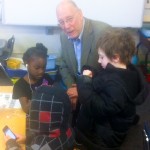A Quick Look at ‘Students as the Real Workers in the Education System’ in Riverside
Posted on | March 10, 2012 | Comments Off on A Quick Look at ‘Students as the Real Workers in the Education System’ in Riverside
Part of Learning 2.0 is being Beta tested in the Riverside Unified School District, the 43,000-student school system 60 miles east of Los Angeles.
At the invitation of Superintendent Rick Miller, I undertook a blitzkrieg tour of Riverside schools last week and came away impressed with how they have pushed the envelope of teaching and learning toward the five principles of Learning 2.0. They have done so without leaving traditional schooling behind.
Impressively, everyone I talked to in RUSD understands what they are doing is a work in progress, an on-going experiment in teaching and learning. Not everything they have tried has turned out the way that they thought it would. Their virtual high school, for example, serves more students in a blended learning mode than it does students who take all their lessons on line. So, they are paying a lot more attention to the advantages of technology as an option for students enrolled at a brick and mortar school. Smart whiteboards didn’t seem to increase student achievement. So, they are using them less. RUSD uses a lot of technology, but the goal to support learning, not to show off digital toys.
Second, the schools have wisely chosen to retain a great deal of what is traditional and valued about schooling. Parents, educators, and administrators steeped in Learning 1.0 will see schools and teaching that they understand and recognize. I still need to better understand how students and teachers blend the old and new, how they step to the edges of their comfort zone without vertigo. Movement to the edges is the hardest for administrators, I think. They have both personal stakes and a sense of entitlement rooted in the old system.
In Learning 2.0, schooling operates under the realization that students, rather than the adults, are the real workers in the system. RUSD recognized this. The district’s technology initiatives have been built around getting consumer level electronics—tablets and pods—in the hands of students and giving them a lot of freedom over how they use those devices.
In several schools, every student is issued a tablet computer or a handheld device. (Students prefer tablets to laptops.) They can take then home, put their own music and games on them. So far, the loss and theft rate has been low, and the district has spent less money on replacements than it previously spent on lost textbooks.
I visited a kindergarten at Pachappa Elementary School, where each of the students was working on an iPod. They were all working independently, and they seemed to know what they were doing. Instructional technology director Jay McPhail said that for the most part the district has not found it necessary to hire adults to teach the students how to use new technologies; the students teach each other. They also self enforce to a degree. In the kindergarten class I visited, one student was correcting another who had strayed from the assignment into another application.
The district is also rolling out a dashboard that contains student progress indicators that are updated almost every day. The dashboard delivers current, necessary data, not all the minutia schools collect. Each student gets data on five or six key variables, including how they are doing on the requirements for admission to California colleges and universities. Student dashboards, along with their texts, are available on district-issued Android tablets. But the district’s system works regardless of the platform the student chooses. Some students use iPads they have received as a gift or bought with the proceeds from part time jobs.
Any adult on campus can ask to see a student’s dashboard. A cafeteria worker can remind a student that this is sixth period and that they ought to be in class rather than sitting on the picnic table. A teacher can look at a student’s academic history and suggest a class that the student might profit from in the coming semester.
There is always the possibility that another student, or someone else, might see a student’s information. But the kind of legally sensitive information about race, poverty, or special education status that make educators wary of sharing data are not on the dashboard. It derives from the official student information system, but it does not replace it.
The student bill of rights initiative
The folks at Riverside are also the force behind the Student Bill of Rights Initiative, and they need to gather about 750,000 signatures for the proposal to appear on the November ballot. The initiative would allow students in any public school to take on-line courses that would meet the University of California or California State University entrance requirements regardless of who offered the course. Currently, state law creates barriers for students who want to take courses outside their home district.
The proposers maintain that more than one million students in the state attend schools that do not offer all the courses necessary for university admission. They also argue that on-line offerings would help lower the remediation courses now required of students, especially at the community colleges. (These claims have been challenged, see comments.)
The initiative would require that on-line courses be taught by credentialed teachers and that they be approved by the University of California.
The initiative is important for a number of reasons. It might actually pass. Although visibly supported by the online community, the education establishment has been slow to endorse it, and one suspects they are waiting to see if the signature collection is successful before weighing in. But it’s safe to say there is no groundswell among the districts.
Whether or not initiative passes, it is important as a signal of intelligent life in California, which despite playing host to the digital revolution ranks dead last among the states in openness to online learning. In addition, it signals an important shift in thinking about how learning is produced. For 100 years, education policy supported a standardized process delivered by geographically based hierarchies.
The initiative suggests that the contents of instruction and its pedagogy may come from many sources, and that students, as the workers in the system, might get some choice among them. It also suggests that school districts might become more network like, linked to one another, rather than vertically connected to the state.
Tags: California Student Bill of Rights Initiative > Rick Miller > Riverside Unified School District





